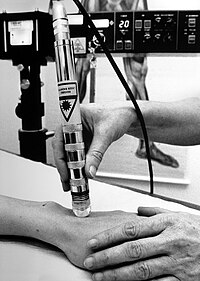
Photo from wikipedia
There is an increasing demand for low-level light therapy devices for the treatment of dermatologic conditions, such as acne, hair loss, undesirable body hair, and skin aging. This study evaluated… Click to show full abstract
There is an increasing demand for low-level light therapy devices for the treatment of dermatologic conditions, such as acne, hair loss, undesirable body hair, and skin aging. This study evaluated the safety and effectiveness of a novel hand-held low-level light therapy device with a 680 nm red laser diode and a 450 nm blue light-emitting diode for the treatment of mild-to-moderate acne. A prospective clinical study was conducted on 57 patients with mild-to-moderate acne and Fitzpatrick skin types II–IV. Treatments were self-administered by the patients at home daily for 4 weeks. Conventional treatment was restricted during the study period. The number of inflammatory and noninflammatory lesion counts, Investigator’s Global Assessment grade, patients’ self-assessment, and adverse events were measured every two weeks, and follow-ups were performed until four weeks after the final treatment. Moreover, we evaluated the bactericidal effect of low-level light therapy on Cutibacterium acnes, a causative agent of acne vulgaris, in vitro. The mean number of inflammatory acne lesions decreased statistically at weeks 4 ( ∗ ∗ ∗ p < 0.001 ) and 8 ( ∗ ∗ ∗ p < 0.001 ). The proportion of Investigator’s Global Assessment grade 3, indicating moderate acne severity, decreased significantly at the final visit. No severe adverse reactions were reported. Furthermore, there was a significant reduction in the viability of Cutibacterium acnes following low-level light therapy exposure in vitro. The results of this study demonstrate that this novel, hand-held, and low-level light therapy device are safe and effective for the treatment of inflammatory acne, with good adherence.
Journal Title: Dermatologic Therapy
Year Published: 2023
Link to full text (if available)
Share on Social Media: Sign Up to like & get
recommendations!